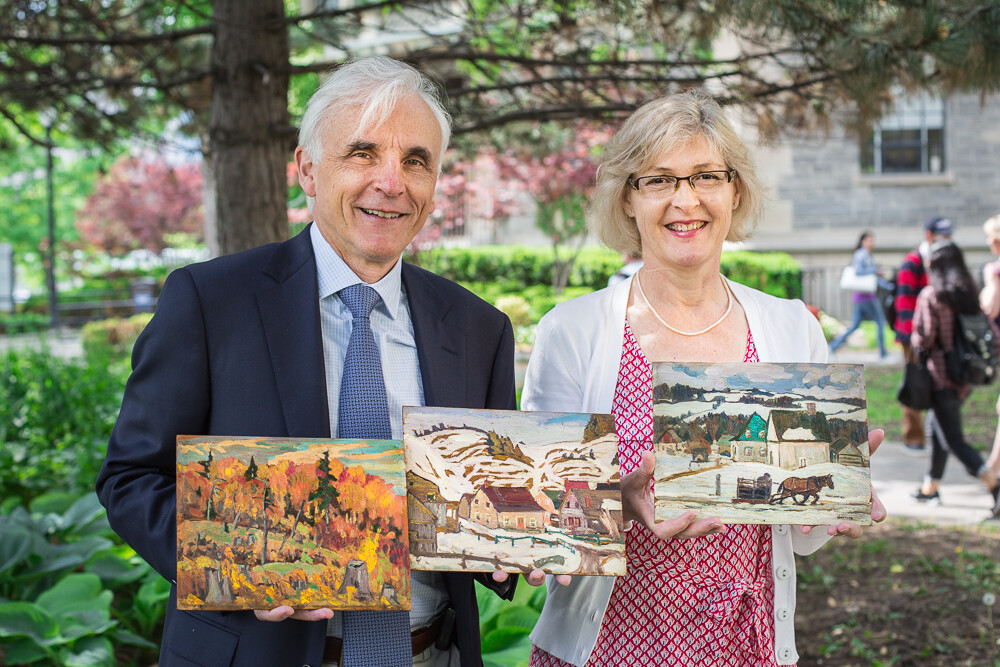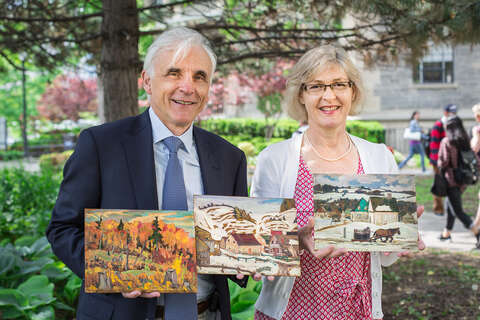The Scientist, His Maid and Three Mysterious Works of Art

Heidi Singer
On a gloomy January day three years ago, Dr. John Floras, chair of the historic Banting Research Foundation, opened a previously unknown safety deposit box belonging to the organization. Inside, he discovered a secret treasure – and a mystery that deepened the more he learned about it.

There were three small oil sketches, two of them inscribed to a “Miss Nancy Archer” and signed by Frederick Banting himself.
“They were painted quickly on birch boards and framed very simply, probably to be hung in a cottage,” recalls Floras, a professor of cardiology at the University of Toronto and an art lover himself. “They were dirty from smoke. But they had potential to be authentic.”
The works were in the Group of Seven style – not a surprise, since the co-discoverer of insulin often took painting trips to the wilderness with A.Y. Jackson throughout the 1930s, in part to escape the pressures of his sudden worldwide celebrity.
An autumn woods scene of Penatang has deep, rich colours, and is dated 1930. The other two, painted the following year, are winter scenes. One depicts a horse pulling a sleigh through fields; the other shows Saint-Irénée, Quebec, a small village on the north shore of the St. Lawrence River.
“They’re very good examples of Banting’s work,” says Dennis Reid, a U of T art history professor who examined the pieces. “He had virtually no formal training, but was a very skilled amateur. He learned a great deal from working with Jackson, and that’s very evident in these works.”
Reid, a leading Group of Seven expert, told Floras there was no question the paintings were authentic. Still, nobody knew how they came to be in the foundation’s possession – and it mattered, because Floras would have to establish their provenance before the foundation could display them.
Ramona Rea, who had just taken over as the foundation’s executive director, began searching for answers. The box contained one clue: a return address from the envelope that the works had arrived in. To her surprise, Rea traced it to a shipping company in England. After months of enquiries, someone remembered that the package had been sent on behalf of Bonhams, the auction house.
“That’s where it dead-ended,” recalls Rea. “Bonhams would only tell me the paintings were part of the disposition of an estate. All I could learn is that somebody died in Cornwall, UK and bequeathed them to us.”
Rea had one more lead to follow: Nancy Archer. Hers was a completely unfamiliar name among Banting historians and other scholars. She wasn’t a fellow scientist, a known friend or relative. In desperation, Rea went to the public library and combed through city directories from the late 1920s and early 1930s.
When she ran her finger down the A’s in 1931 a thrill ran through her. Nancy Archer was in the directory that year only, and she was listed at Banting’s address on Bedford Road. At that time, people’s occupations were listed in the directory. Nancy Archer was Banting’s maid.
“We assume he gave them to her as a gift. He gave away a lot of his paintings,” Rea says. “He didn’t ever want to be paid for his paintings, so this is what he did. If we could only find what happened to her, this would solve a big piece of the mystery.”
Meanwhile, the discovery had great personal significance for Floras and the other board members of the foundation, which was going through a renaissance at the time. The Banting Research Foundation holds a unique and often overlooked place in the history of Canadian medical science, having been established in 1925 with great hope that it could fund another discovery like insulin. There were no university or hospital foundations and no government funding agencies in Canada at the time – and there wouldn’t be anything similar to the Banting Foundation until after World War Two.
“It was astounding timing, finding those paintings at the same time that we were working to renew the foundation,” Floras says. “It was as if a number of threads had come together. I was holding in my hands something Banting touched that nobody knew about. His paintings showed that medical research could be equal in creativity to writing a poem or a play. It made me want to renew the foundation.”
On Wednesday July 22, the foundation celebrated its 90th anniversary. Over these decades, the foundation has used its small but historically influential endowment to support emerging scientists conducting creative research, similar to Banting himself. Today, it receives double the number of applications from five years ago.
Floras hopes to display these works so others can be inspired by the renowned scientist who found such joy in art. But the foundation is still trying to establish the identity and intent of the sender. Publicizing their story is one way to learn of the history behind these painting and their journey back to Canada – and it might lead to new details about Nancy Archer and any possible descendants.
“There’s got to be more to the story and that’s what intrigues me,” says former board member Laura Formusa, who was with Floras when he opened the vault. “How did the paintings end up in England? Why were they sent here anonymously?”
Formusa, like Floras, finds Banting’s lesser-known artistic life inspiring.
“Maybe this will help other researchers to explore their creative side,” says the former Hydro One CEO. “To see someone expressing himself in that way is inspiring. And it’s the ultimate connection to the man because everything deteriorates. Art is a wonderful medium through which a life can live on.”
News


